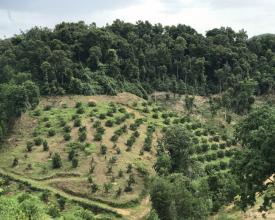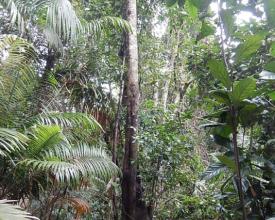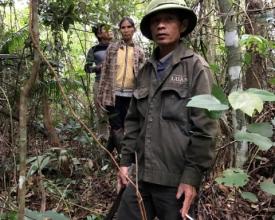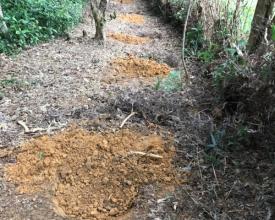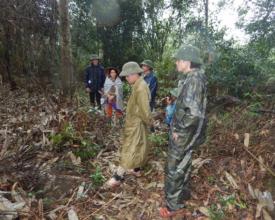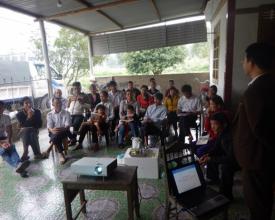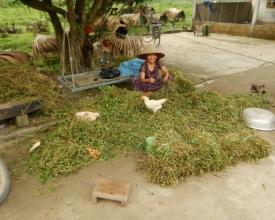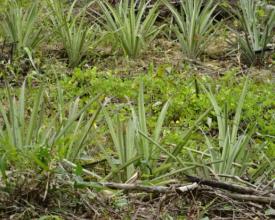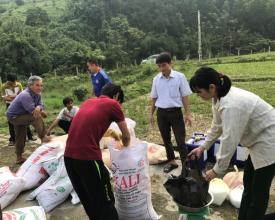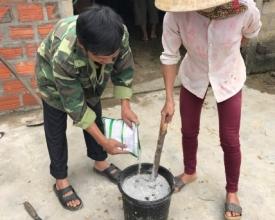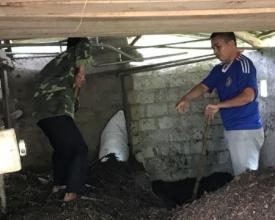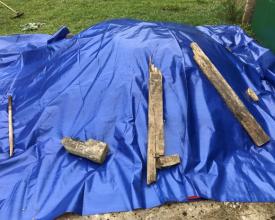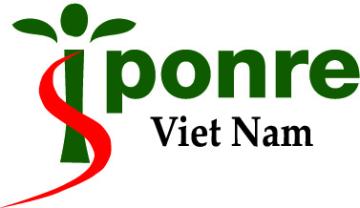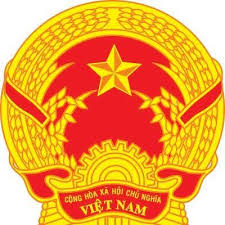
Forest protection and restoration for buffering extreme droughts in Ha Tinh province, Vietnam
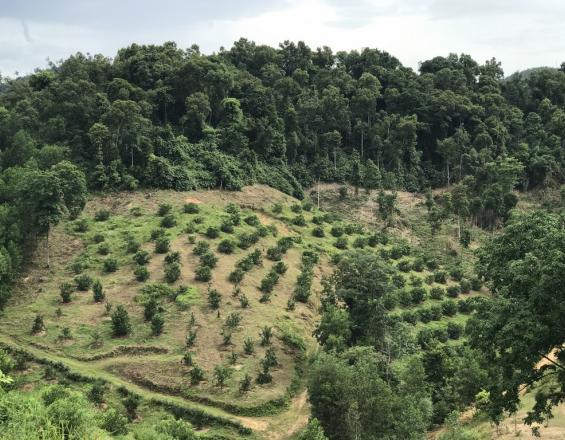
Son Tho commune authority and villagers experience several climate change hazards, including cold spells and droughts, and some rainfalls. Severe and increased droughts bring numerous adverse impacts to people and ecosystems. Forest protection and enrichment are effective drought buffers and the most promising EbA measure based on consultations & a vulnerability assessment. This solution includes activities in the top, middle and low parts of the hilly terrestrial ecosystems. This solution is strongly linked with the EbA Solution “Strategic mainstreaming of Ecosystem-based Adaptation (EbA) into planning frameworks in Ha Tinh and Quang Binh Province” and builds on its vulnerability assessment as a technical response, covering community involvement, technical trainings and field implementation.
Context
Challenges addressed
Natural forests in the area are increasingly converted to short-rotation plantation, mainly Acacia hybrid (hereafter acacia) for wood chip production. This conversion leads to degradation of ecosystems with run off and erosion, reduction of services such as water resources and non-timber forest products. Weather variability exacerbates this reduction that makes adaptive capacity of local residents and ecosystems worse.
In particular, severe and increased droughts brings numerous adverse impacts to people and ecosystems, which are: i) Rice growers could not cultivate the second rice crop in the lower part of the spot due to the water shortage; ii) Fruit trees and annual crops in the middle part of the spot (orange, peanut, maize, green bean, cassava, etc) did not grow well and many died; iii) Shortage of water for human use (people often use ground water from wells and surface water from streams in the forest directly); iv) Many lands are left as fallow during droughts.
Location
Process
Summary of the process
The solution has different blocks which are connected to each other. Planting native timber (BB1) on the mountain top to provide underground water that offers moisture to the lower part provides water to humans and paddy rice fields, and protects all lower parts from strong wind. Planting pineapples and pinto peanut (BB2) between orange fields next to the top retains moisture, controls runoff and erosion, and improves soils. Making compost from agricultural residue (BB3) provides organic fertilizer for orange trees and crops.
Building Blocks
Restoration of degraded natural forests with native trees in the top section of the hills
Planting started in 2016 December for:
i) protecting and enriching the existing natural forests in very low density and poor composition,
ii) introducing comparative advantages of natural forests against acacia plantation,
iii) raising awareness to local residents on utilizing ecosystems suitability.
Forests were protected and enriched to provide different services to other ecosystems and human, such as food and non-timber forest products for daily use and income, regulation of micro climate, underground water, and extreme weather conditions.
54 households whose forests are connected to each other joined the activities. They were then trained on enrichment, including on-hand practical exercises in their forests. Forests were enriched by strips and spots; depended on the current forest status that was checked by technicians. Three native species were planted, including Erythrophloeum fordii (Iron wood), Cinnamomum iner (Cinnamon tree species from SE Asia), and Manglietia glauca (Magnolia tree). These species were planted by single rows along contours. The survival rate was 95% and all trees had new growing points after 2 months. Plantings are taken care and checked by farmers.
Enabling factors
- Various aspects made this planting possible. Farmers understood the importance of keeping natural forests for their own lives. This lead to their commitment and hard work in their forests.
- Also, the planting is compliant with the district and commune development plans on the enrichment of natural forests by native species.
- Lastly, their work was closely monitored and supported by technicians to ensure the planting was done correctly and to motivate them for the hard work.
Lesson learned
- A large group of farmers is interested in clearing their forests to plant fast-growing species for short rotations.
- In addition, governments lure investment in industrial work including construction and processing factories that need raw materials from fast-growing species. These trends support farmers who easily decide to convert natural forests to short-rotation plantations for their daily lives and income.
- Besides raising awareness among farmers about the benefits that natural forests bring about, the project team worked closely with local authorities to ensure that the protection and restoration of natural forests was implemented effectively.
- Another important point was involving farmers who are passionate about natural forests and act as 'role models' to other families.
- Lastly, the process was transparent and farmers had their voiced in the entire process.
Contour planting with pineapples and pinto peanut in orange fields
This planting started in 2017 March for:
i) reducing runoff and erosion in the steep orange fields,
ii) keeping moisture content high for orange trees,
iii) protecting the top soil layer,
iv) increasing soil fertility, and
v) minimizing grass cover that competes with orange trees.
Thus, this mixed planting can provide a number of services to growers, such as fruits from orange trees and pineapples for income, fodder for animals and materials from pinto peanut for compost and improvement of soils.
12 households participated in this planting. They were selected from community meetings based on criteria (committment, site characteristics, labor force). Two members each household were invited for the in-class technical training on doing this planting. Trainers provided planting techniques in localized discussions and lessons learnt. Farmers were also offered on-hand practical part in their own orange fields for the detailed and real application.
Pineapples were planted as contours between orange rows, by serrated planting to ensure erosion control function. Pinto peanut - a nitrogen fixing plant - was planted between trees. The survival rate is almost 100%, pineapples already offered the first fruits. This activity is continuously taken care of and checked by farmers.
Enabling factors
- One of the success factors of this planting was communicating its values to farmers. Because pinto peanut was completely new to farmers and commune staff, many felt reluctant to apply it. Technicians and the project team implemented good practices to show locals.
- A second factor was that technicians used traditional knowledge in training, which helped farmers understand this approach.
- Frequent checks were offered to support farmers and motivate them for their hard work.
Lesson learned
- Planting pineapples and pinto peanut as contoursr in orange fields is more time-consuming than cultivating orange trees without anything in between.
- Farmers had to do many different tasks to get pineapples planted in serrated rows and pinto peanut planted in beds. Thus, information on technical requirements should be clearly explained to farmers in the beginning.
- First time application should not cover too many households.
- This application is new to farmers, so frequent checks are very important to make sure they stay interested and commit to the work.
- The third lesson is involving a local institute (the agroforestry unit in this case) to enable the introduction and replication among other farmers and areas where possible.
- Participating households should be carefully selected because households with many livelihood opportunities might not participate because they will focus on activities for good income, rather than this approach which mainly provides environmental value rather than increased income.
Producing compost for crops
This planting started in 2017 August to:
i) maximize available resources, make use of agricultural by-products, volunteer agricultural labor to produce bio-organic fertilizer with high value,
ii) enhance soil micro-organisms, rapid decomposition of organic matters, eliminate and destroy harmful microorganisms that exist in manure, support plants to increase their resistance,
iii) contribute to environment protection, reducing the toxicity of chemicals in agricultural products due to the abuse of chemical fertilizers,
iv) raising awareness to villagers in clean environment.
Hence, farmers will have a number of benefits from compost they make, including, access to fertilizer resources with reasonable price for their conditions, less depending on markets, keeping the environment clean and ensuring good quality of agricultural products.
18 households - selected from different community meetings – participated in this activity and received technical trainings on producing compost in a step-by-step process combining theory and on-hand practical implementation in their gardens.
Enabling factors
The following factors made this activity effective:
- Farmers paid special attention to applying scientific knowledge to their crop production activities for better products,
- the necessary materials were locally available,
- weather conditions were favorable for farmers during the implementation as there was little rain and low humidity.
- Projects provided a small amount of inputs such as Trichoderma probiotics, molasses, and lime
Lesson learned
- Compost can be produced in the amount that farmers need for their crops and trees.
- Even though only 18 households took part, technical material was shared with other farmers
- Growers should understand how to use compost in the Integrated Pest management process, in particular how to use compost for trees and crops in certain growing stages (for example, the fruit generating period is important).
- Frequent checks should be made to ensure the compost is in good condition.
Impacts
Environmental:
- Forests are well maintained and provide more goods and services to be less vulnerable to extreme weather events, including (provisioning services - increase of organic food for human's daily use, food for animals and bees is stable over years, water for second term of paddy rice, human and animals; regulating - water storage capacity for humans, crops and animals, micro climate regulation; supporting - improvement of habitat for other species)
Social & economic:
- Farmers have stable income from forest goods and services that support them to tackle climate change impacts. Thus, they better adaptation capacity from well-managed forests (reduction of number of water scarcity days; goods and services provided by healthier ecosystems).
Beneficiaries
70 households managing 65 ha of natural degraded forests directly benefit from measures. Other residents nearby and about 100 ha of inland ecosystems also benefit indirectly.
Sustainable Development Goals
Story
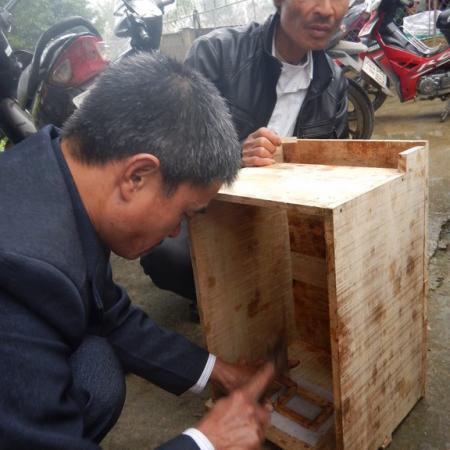
Mr. Nguyen Thanh Hao moved up to the commune when he was a toddler. There are 5 people in his family, including a 95-year old father, his wife, 2 secondary school children, and him. He has 4 ha of forests, half of which accounts for acacia plantation, 2 ha of orange trees that bring the main income to his family, 0.2 ha of annual crops including sugar cane, paddy rice and maize. Livestock includes 2 cows, 1 calf, 30 chicken and 10 bee hives. He experiences that a large area of natural poor forest is converted to short-term plantations, mainly with acacia for pulpwood. Acacia growers can get an income in 5-6-year rotation with this fast growing species, requiring only a small investment. However, this conversion leads to many negative impacts to the ecosystems. Land is exposed to heat on hot days and severe run-off during the rains, so the top soil layer is degraded after each rotation, causing floods to become more extreme. No other plants could grow under acacia canopy due to density. Short rotation leads to poor underground water resources. As a result, water for human daily needs and crops in lower parts of the area is reduced in terms of quantity and quality. Mr. Hao and other households had to shift from 2 paddy rice crops per year to 1 paddy rice and 1 maize or cassava due to water shortages. This problem is exacerbated by unpredictable weather conditions. The GIZ project provided him with native timber seedlings to add into his natural forests in the top, orange trees in the middle, pineapples and pinto peanut between the orange fields, bee hives, and compost. Mr. Hao and other members understood that they should keep the existing natural forests rather than clear cut for acacia, for a number of benefits, including provisioning services - firewood, sprout, grass for animals, water for humans and crops; and regulating services - underground water, micro climate, habitat for other plants under the canopy. While he has to invest more time for his orange fields, the added plants reduce erosion, keep moisture and improve soils. His family clearly confirms that, planting native timber is not for his generation, but for the future, even the far future, they would be happy to protect the ecosystems for his other crops, for nearby families and for the ecosystems themselves. They enjoy seeing birds and beautiful flowers around, and agree that they are doing the right thing.
